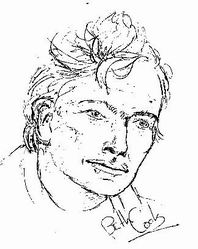


Like my dear Father George and Mother Ray before me, I shall try to write an account of my life for any to read who may care to. Scientific aspects of my life can be found in my Science Story page
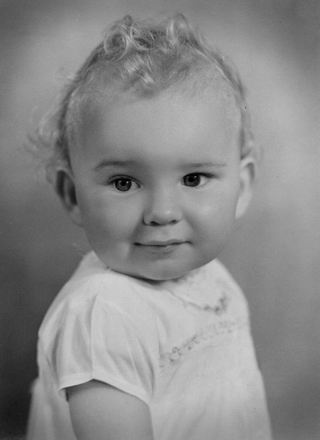
The picture in the left hung in our lounge throughout my childhood at Hayes Chase. How strange it is that my hair now seems to have returned back to its original distribution!
Looking back it seems as if I was born at a most fortunate time.
It was a time when mothers were at home to look after their children. It was in
the Grammar School age when a fine education was to be had if only you could pass the exam.
As children, we didn't just walk to school at 8, we took the bus, then the train,
then we walked! Who knows if child molestation was up or down compared with now, but it never
bothered us or our parents. It is not that we did not experience it. It just
caused no significant problem. The roads were empty by today's standards and we
could cycle long journeys with little risk. My university days at Magdalen, Oxford
were in retrospect a pure joy and a superb education. Dear Avebury house could
not have been a better place to raise a family. How lucky I have been!
I was born on 28th June 1938 in a private Nursing Home in Beckenham, Kent.
These were days before the National Health Service. They were not
auspicious times. War had broken out on 1939 and times were hard.
We lived at 6, Hayes Chase, West Wickham, in South East London. My mother and father
had bought the house new in 1936 when they were married. It is still there
and now part of a rather typical London suburb, but in those days there was
the "waste ground" at the end of the road - a wide area of woodlands
and allotments which stretched for miles to open fields. It was a lovely
playground! My father had an allotment, as I have now. He also kept
chickens in a large pen at the end of the garden, as we did a generation later,
and as my daughter Lizzie now does.
So in those war days we were never hungry and were probably fed very healthily.
My Father worked for the Civil Service
at the Ministry of Supply where he was Deputy Director of medical
Supplies in Kensington, London. Every day he would
catch the bus to Bromley South station, and the train to Victoria,
and walk across the park to his office. We must have been quite well
off for we had a maid, Joan Pocock. She was very young when she came to
us, but was part of the family. She later married and named her son Colin.
It was a
pleasure to see her again at Ray's 90th birthday party! My mother
had had a good job in the Civil Service but she had to give it up
when she married, and never worked again.
She stayed at home and looked after me and my sister Delia, 3 years older than I. When I was 18 months George was transferred to Leeds from January to
September 1941. Perhaps my first
memory is of sitting up in the back of our car, and seeing a furniture
van ahead of us, and asking if it had our furniture in it. It did not. It was a
traumatic journey as there were no road signs, it was winter
and we arrived in deep snow. In fact we did not stay
there long and George was returned to London within the year. Another early memory is of my Father listening to the BBC news
each day and crayoning in the advances our troops had made that day
on the Western front on the large map stuck to the wall by sticky
tape. Each day he would listen to the BBC 9 o'clock wireless news
and listen to the progress of the war. Out would come his red pencil.
That map has survived - torn and worn- but still in one piece!
You can easily see the markings of each day's progress in the image The house had a lounge at the front which was not much used. Instead we
lived in the dining room - the back room with French windows looking
out to the garden. The kitchen had an "Ideal" coke boiler for the hot water
(no central heating!), a very sturdy central table, a big deep sink, and a
mangle for drying the clothes.
Like so many of those 1930's London houses, we had big gardens.
It had a front lawn with a stone "noddy" in the middle of a circular bed.
It survived a further 40 years through two house moves by my parents,
until one sad day in Sussex it was stolen! In the back was a rose bed with crazy paving and a wonderful Laxton Superb apple tree.
Behind was a splendid lawn with flower beds on each side.
Then behind that was our very solid air-raid shelter. The chicken run was at the end. We had two good toys in the garden, a very sturdy metal swing
and a solid concrete sand pit made by my father. I can still remember such
happy sunny mornings playing in the wet sand of the pit. I suppose these
days it would be banished as "dirty". Every blue moon my father
would get some new sand and all would be clean again! It was a happy childhood. We had few toys by today's standards, but
they were good toys and I loved them. I remember most especially my
big wooden bus, which was given to me on
my 3rd birthday. My Father was in the Home Guard and went firewatching
on the roof of the Gaumont cinema in Bromley. It was made by one of his
colleagues there in his spare time. The bus is still with me in my lounge,
and much loved by all grandchildren.
Another toy I especially remember was my pedal car. I do not
remember its history. It was all metal and very sturdy and could be
driven at some speed. How lucky we were that the traffic was so light
and there was no problem in driving down the edge of the road!
The picture illustrated is now mounted next to one of my son Jonathan, at
about the same age, driving a very similar car on the pavement outside our
family house at Avebury. Why do young boys enjoy cars so much, especially during the war when our old Morris 10 was "laid up" in the garage. 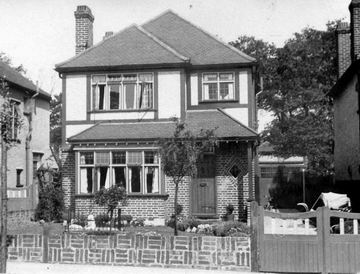
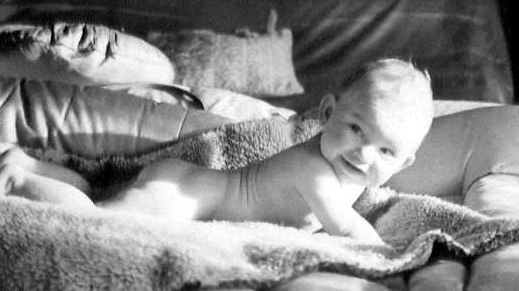
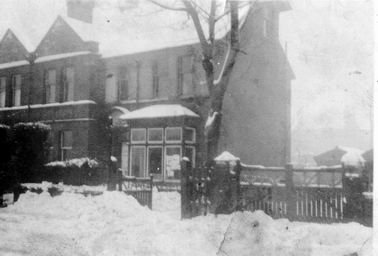
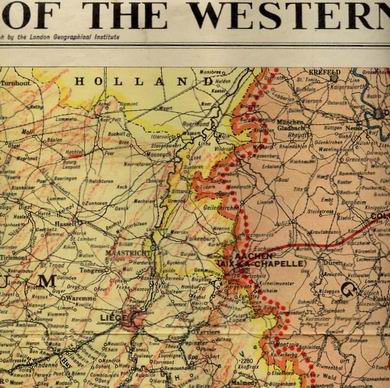

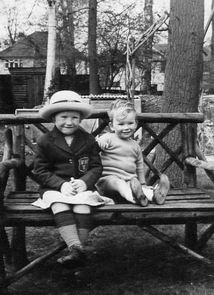
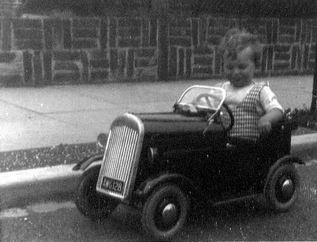

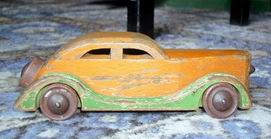
I have a DAD whose name is POP
And when I hear his cheerful knock
I hope a letter will not flop
I know if his love did ever stop
My heart, I'm sure would drop.
How long those toys used to last compared with our present toy culture! Another favourite was the wooden car illustrated. It was absolutely solid, and designed from layers of solid wood to be indestructible. You could tread on it, whiz it across rooms. It might hurt the furniture but the car remains undamaged with its original paint to this day. It now belongs to my grandson Oliver.
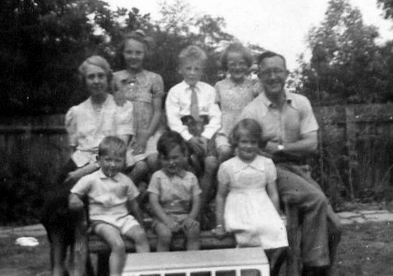
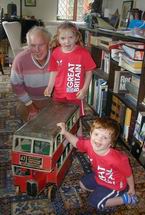
These were war days, and our lives were overshadowed by the bombs even as children. We lived in South-East London, on the path to the City and most days the siren would go off with its two minutes of up and down wails. What was to be done? We had this magnificent shelter down the garden. It was underground, with daffodils growing over it in Spring. It had about 10 concrete steps down into the earth, to a usually wet and puddley "foyer". This had a great iron door, with heavy metal catches, into the inner sanctum. There it was quite cosy. There were two camp beds for the grown-ups, bunk beds for us children, electric light, and even a fearsome open-wire electric radiant heater. Often we would go down there at bedtime spend the night snug through the air raids. During the day, we would just go down briefly. The structure is still there. We visited the old house with my Mother while she live with us much later. The lady of the house was most welcoming and showed us round with pleasure.
It was more difficult when we were away from the house. Public shelters had been built all around the neighbourhood. I mostly had cause to visit the one near the 138 bus stop on the way to Bromley. They were sociable and quite cheery places to visit. One simply waited the minutes until the long constant all-clear wail came over the siren.

There were various types of raid. I do not remember too much of the German planes. But I did have a wooden "tommy gun" with a handle that you could rotate and make a rat-a-tat machine gun noise. I do remember following by father in ignoring the air-raid siren and standing on the grass top of the shelter pointing my gun at the planes and hopefully firing. Later it was much more common to have "doodle-bug" flying bombs coming overhead. These were little unmanned jets which would fly high over our heads. The worry was when their engine had cut out. It meant that they would be losing height and might well explode nearby. Later still were the proper "V2 rocket" planes which flew over a bigger and higher trajectory which would end by and almost vertical dive. At supersonic speeds there was almost no warning and the first one heard was a big bang.
What a worry it must have been for our parents! As children we took it almost for granted having known nothing else. As my Mother's account describes, we children became "Cogs". These were little cogs in the giant machine of the war effort. Our job was to go round the bomb sites with our little barrow, and collect material for the "salvage" boxes. There was a bomb site immediately opposite our house through all my memory of the war (The bomb had dropped while we were in Leeds). On the site was a large metal shelter with boxes for timber, paper, cloth and metal. A great deal was collected and soon disappeared from the containers.
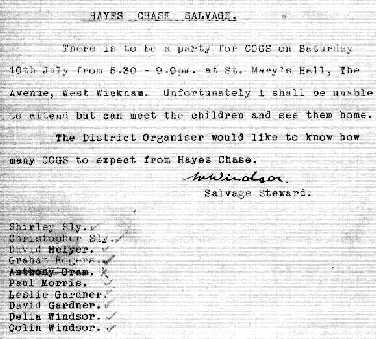
Across from Hayes Chase entrance was a large area of "waste ground". It is now all housing, but then it was simply abandoned ground, woods and allotments. I remember one exciting day when army exercises were under way there. In almost no time at all, a giant digger had pushed the earth around to create a 20' high mound with steep edges but a quite smooth ride up and down each side. Of course it was perfect for a young boy's bike and was extensively used through much of my childhood. Another excitement was when they made a "tank trap" further out. This was steeper with a long often flooded ditch and long high causeway above it. My Father's allotment was perhaps 400 yds away from our size and the usual standard size of one pole long. Often I would go and help him there delighting to watch the monster marrows growing on the compost. It meant that we were not hungry, and had abundant supplies of the most healthy foods. The vegetables were complimented by the eggs from the chickens in the garden. It was quite a bit of work. My parents would boil up mash with potatoes and the household scraps each day. It would make an awful smell in the kitchen. The yield was very seasonable. In late spring there would be a glut and out would come the giant container with the "waterglass" preservative, that would keep the eggs from going rotten for many weeks. They never tasted so good, but were fine for cakes.
We children had quite a good sociable time. I can remember lots of
birthday parties with the neighbours. The Seniors next door had a girl
Doreen a little older than Delia and was a good friend. Further down the
road one family, the Evans', Mac and Renee were to become lifelong friends,
especially to my mother who would have long phone chats with Mac to the end
of her life. They had two boys Brian and xxx, and I can remember parties
with their real steam-fired model railway to play with.

There was lots going on in the road. Everyday the milkman came round with his
horse and cart. I remember sitting next to him on his driving seat sometimes. One
day he took me to the end of the road with the horse galloping along
at high speed. A few times a week the even older Ackerman's bakery horse and cart
would come round with the bread.
I never felt a lack of toys, although their number must have been very small.
I had many "Dinky" cars - several I still have. My favourite
was my Lagonda sports car with its open top and long-gone perspex windscreen.
I also had plenty of wooden bricks of various sizes. They were kept my mother
in a red bag for grandchildren to play with, as they still do.
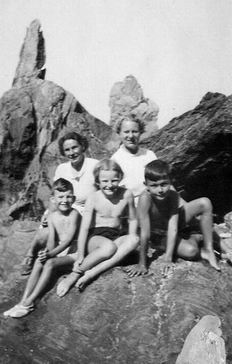
When I was 5 I was sent to join my sister at "Dartry House" a private kindergarten
school about half a mile away towards Parklangley. My first teacher was Miff Miff
(Miss Smith) and I was very happy there. I can remember learning to tie shoelaces on
a big board with 5 sets of ribbons. Of course it was wartime, and we had to take our
gas masks to school with us. I was very lucky to have a special children's one with
an animal-like shape and special "nose" which went up and down as you breathed.
We made friends there with the Marshall family, Gary and Gwen, who had a son Malcolm
about my age. In the summer of 1943 our families went on holiday together to Hope Cove in Devon.
It was a long
journey on a steam train, which put smoke soot into your eye if you looked out of the
window. We arrived we were hungry and our landlady gave us home-made scotch eggs.
The Marshall family moved to Australia, but we always remained friends and much later
I visited Malcolm there.

When I was seven I moved with my sister Delia to "Bromley Convent", a lovely girls school which had just a few infant boys. It was a long journey there. We walked over the waste ground to the bus stop. There was the 138 or 146 bus to Bromley North. Then a long mile walk to the school. We didn't mind and never came to any harm. It had big spacious grounds and I can remember happy summer days exploring in the long grass. We were taught by nuns who wore elaborate black and white habits. Nearly everyone was catholic and I can remember feeling a bit left out when most of the pupils had to go and say "confession". I wondered what it all was and took surreptitious glances though the window. The picture is from 50 years later when we took my Mother Ray to see the old school. It had hardly changed.
I stayed there for just two years and then moved on to a boy's private school,
"Dulwich Prep." It was a really old-fashioned school with a strong headmaster, Mr Leakey.
To get there was an even longer journey journey - the bus to Bromley South, then the train
to East Dulwich, then a good walk up to the school. Oh what joy to be whisked home one
day in an open-topped green MG, driven by a glamorous mum, with about 6 of us sitting around
at the back!
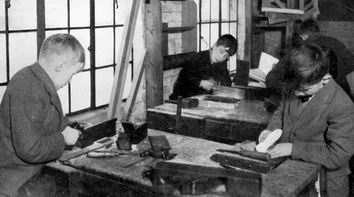
There were some kind teachers. One taught us woodwork in an ancient workshop at
the end of the playground. He taught me to saw, and use a chisel without cutting myself.
I once made a really complicated doll's house. It was for Delia, but in the end it looked very home
made and a bit small.
A highlight of the summer was going to Dulwich College outdoor swimming
pool where everyone swam naked! It seemed very exciting somehow to an 8-year old. Somehow
kind Mr Hamilton taught me to swim using a sort of fishing rod suspending a strap which went
round your waist. We had a lovely sport's field but I never excelled. I can remember cricket
and bowling as hard as I could but the ball did not even reach the opposite wicket. On sports
days we would go home from "Sydenham Hill", and old station tucked under Crystal Palace hill.
I would watch the men patrolling the long tunnel with their oil lamps.
One exciting toy I had in those days was a toy sailing yacht modelled on the 1934
boat "Endeavour".
This yacht, designed by the aero builder Sopwith, had all the best of design and materials and
"swept through the British racing fleet and into the hearts of yachtsmen the world around."
My boat was only 67cm long instead of 130 feet but it was a delight to the eye.
And it sailed well. My father would take me to the park in Bromley with its round pond and
it was sail across back and forth. The wind had to be right as it could easily topple over.
When I was 10, in 1948 we moved from Hayes Chase to 8, Holland Way, Hayes. It had
a lovely position close to Hayes Common,
a wooded open space that went on for miles. This was our private playground.
The link brings as essay I wrote in 1952 and a map written even earlier.
The house stood near the top of a big slope and had big "foundation" cellars beneath
the main house. Being olympic year in London, George arranged for an interlocking ring
pattern to the new balcony rail that he had installed. I thought the original garden was
just fine, but George had everything redone.
The chickens came with us, and I remember going
with George to buy a very grand house for them. They gave us lots of eggs. Every morning
early before breakfast, as he made early-morning tea for everyone, George would make up
their food from potato peelings and corn.
Every Saturday morning George would clean out their house. I do remember the super cooked breakfasts that Ray cooked for us all. There would always be cereal then bacon or sausage or "cheese frizzles" that we enjoy to this day.
Soon after we came to Hayes, I joined following my school friend Gorden Bartlett the Crusaders - an evangelical Bible class which met in a scout hut at Hayes. I learnt much of the bible and many "choruses". I went to "camps" at St David's, Studland, and Polzeath. They were very disciplined and organised. I enjoyed them and made many friends.
Colin's father had as part of his job in the Ministry of Health visited factories. One day he took Colin along to a lens factory and he came away with a stack of reject lenses, large and small.
There were 4 bedrooms and I had a lovely big room at the back for my own. I still have the lamp that graced my bedtable. I had a double chest of drawers with three full length mirrors which could fold to make any angle with eachother. By standing in the middle and putting the two outside mirrors parallel to eachother, you could see a million copies of yourself.
The large middle section remains our present bedhead!
There was never any central heating in the bedrooms, b
that you could warm yourself over! The drawing shows part of my room with the chair I would read at in front of the 2-bar fire, and the desk where I would write.
I mentioned the cellars. In fact the whole of the ground floor was doubled up beneath the ground floor. Very early on the table tennis table that had come from Hayes Chase was installed in the first room you come to. We had many happy games, especially with Ray who always played an
excellent game of table tennis. This is the very table, now some 60 years old, which now rests along the wall of our hallway, and is taken out daily to put on the dining table in our lounge. What a good game table tennis is! It gives good exercise at any desired level of intensity to both body and mind. It can be played at some level at all ages, even toddlers and 0-year olds! The equipment is pretty cheap or easily available, and never seems to wear out. Our table is now probably 90 years old and my childhood bat now keeps it in place.
Around 14 I went with my sister Delia to Paris, in fact to Versailles where we attended a course to improve our French at a plumbing school. I remember early glimpses of French life with glasses for wine being busily polished for ages before we were allowed our tiny drink.
We had a lovely day in Paris.
There was always music in the house. The big upright Bechstein piano, that Jonathan
now has, sat in the living room and was much played. I can remember my first attempts
at trying to reproduce the signature tune of Dick Barton radio series. I was a bit
peeved that my parents thought I had invented a new tune. I started piano lessons with
Miss Massey. She lived near Pickhurst Green with her very elderly mother, you always
sat in her arm chair in the living room during the lessons. Miss Massey must have
had hopes of love for numerous photos of handsome tenors adorned her grand piano.
But it was not to be. She remained unattached, keeping up with her old pupils for
many years. I took my Grade 1 Piano on 16/7/47 getting 110/150 with remarks like:
"Playing a bit aimless at present!" Later my lessons would overlap with my friend
Owen Williams. We could not have been too bad, as we would go in for the Bromley
Music Festival duets and always seemed to win. I remember enjoying the naked figures in the
winner's certificate!
Cycle rides were a part of my life as soon as I gratuated from my tricycle. I had a good upright Triumph and I went everywhere on it, as I still do. In those more traffic-free days it was freedom indeed to go off where I liked on my bike. In 1953 at 15 I joined the YHA and began some quite extensive trips with my friend Lucas. The first was for 5 days in Kent. The year after we went to Devon staying at 9 hostels, What an excellent organisation the YHA is! It introduced you to your own country in such an enjoyable atmosphere. Its good to report that 70 years on the cycling is going as strong as ever, and we are still members of the YHA.
These were the days of the "11 plus" exam, when everybody had to take a exam in English and
Arithmetic and an IQ test. I remember going on the bus to a strange new hall for the exam.
It was not taken at school. I remember too writing a really long English essay, and it must
have been OK. as one day a master at Dulwich Prep came to tell me I had got into
Beckenham and Penge Grammar School for Boys - the same school but not the same building
that my father had attended. I remember being slightly disappointed as I had also had an
interview for Dulwich College. I remember reading an unseen passage from a book and not
doing too well.
Beckenham Grammar School was a superb school. I would catch the 8.13am train from
Hayes to "Kent House" station and walk the mile to school. The Head was Mr White (Jumbo), who ruled with a
detached fair discipline. Each morning he would preside over School Assembly when all had to attend
hall, sing a hymn, listen to a reading and prayers and then the day's notices.
We had a 4-class intake each of about
34 boys. After the first year nearly all subjects were streamed and one had to work hard
to keep among the best streams. My first class teacher was A Mr Bradman who taught us phonetic
French. He was a staunch
communist and would sell the Daily Worker in Penge High St before school.
He never forced his opinions on us.
After ticking off the class register each morning, he would
send us to other classrooms around the school to the classrooms of the teacher for that lesson.
We would wait outside each classroom in a disorderly queue supervised by a prefect.
The poor prefects, and I joined them in the VIth form, had to do essentially all the
discipline and had their own detention for punishment of unruly boys. Two prefects would supervise lunch
on the school stage while a supervising master sat reading the paper ignoring the whole proceedings.
It worked very well.
The school had plenty of music. I sang treble in the choir and soon graduated to clarinet
in the school orchestra. We had
"AlFresco" concerts (always in the hall: there must have been
some rainy times.) The picture shows the full orchestra under the direction of our music master
Mr Smith, organist at Bromley South. The inset shows three young clarinettists,
the "WinClarRic trio" (Windsor, Clark and Richards). We appear on the extreme left of the
photo. On 21/7/1951 we did a solo trio of "Trees" which must have been pretty painful.
Following my sister Delia, I took up the guitar which goes so well with singing. My father took me to the Charing Cross Road where we bought the lovely Spanish Segura guitar I have played ever since! At an Alfresco concert in 1957 Colin played guitars with Trevor Cumming. As the Kentish Times reported, "A T Cumming and C G Windsor charmed us with their double guitar playing of
Granados' Andulucia, which had true Spanish feeling and a nice ease of rhythm. The unusual combination of recorder and guitar in a Bach aria was very pleasing." With Delia we heard Segovia play at the Festival Hall. It is good to report that over 60 years on, and with numerous changes of strings, the guitar sounds as good and still provides the most gentle music to calm the soul. I still have the old book where I wrote down my first pieces. My guitar went everywhere with me including across America in our Volkswagon car.
Team ports was treated with great enthusiasm by many, although not by me. We had a lovely
sports ground at Parklangley with room for umpteen pitches of soccer, rugger or cricket.
I preferred tennis, and reached the 2nd VIth, and cross country. We had our home cross country
runs on Hayes Common, just near home. One year I came second in the main school race and was
promptly made Secretary! Actually it was a delight going round most Winter Saturdays
to faraway London suburbs and running round delightful courses.
Chess was taken very seriously by some of the pupils. Doing it enabled you to skip going
to the playground at break time and could instead go to the Art Room presided over by the
gentle art teacher Mr White. He would sometimes preside over us from the top of a ladder while he
painted scenery for a school play. The chess standard was high and some of us eventually played
for Kent Juniors in London.
The science VIth were a close knit set of friends. In my last year 25/7/56, Martin Galley
took this photo. Chris Newall, Colin, David Fiddes, Chris Paradine, John Mills, Gordon Bartlett, David Heyhoe
and John Davidson. We were to meet again 59 years later for a reunion when a similar picture was taken.
I had a very happy childhood with few worries. I do remember problems with my maternal
grandmother "mother" Emily, who lived at Worthing with my Uncle Grey
and Grace. He was 10 years older than my father and had had an interesting life in Malaya.
They needed a lot of help. She died in 1969, he in 1971 both in their own home.
After A level Jumbo suggested that I try for Magdalen, Oxford, where Adrian Brine had recently
been accepted. It meant staying on in the third year VIth form and taking the entrance exam
in December. I remember the trip so well, and the room in the Cloisters where I was put for the
night. I did my first walk along Addison's Walk- around the little triangle of meadow formed by
a triangle in the Cherwell. The hardest part of the exam seemed the "German for scientists", and I remember doing the
Latin instead. I passed with a Demyship - the Magdalen name for a Scholarship. It means half a fellow.
I left school and managed to get a job for six months with Mullard Research Labs at Salford, south
of Redhill. I soon got used to the long journey by bus and train. I had the nicest boss Kurt Hoselitz
who taught me more than experimental work. There were intelligent pretty girls around me for the
first time. The clever radiographer sat next to me on the bus. Each lunchtime we dined in the excellent
canteen and walked up and down the country road beyond the labs.
Soon it was Magdalen. I had a lovely room in St Swithin's Quad. The view from my window is shown in the picture. It had once been the sitting
room of a pair of rooms. The door adjoining the two rooms was thin and I learnt much from the
lovely music that would filter through - Beethoven's Violin Concerto, Strauss' Last Songs.
What a strange feeling it was to be free of my kind and loving parents. I could do whatever I wanted!
The greatest delight was to be surrounded by so many friends. In those days you signed up for all
meals and these were taken in Hall on big long tables with bench seats. It was a good scheme.
You tended to sit down on the next empty seat and it was so easy to meet new friends. After lunch
was the long Madgalen tradition of a spin around Addison's Walk - the island triangle in the
Cherwell where the fritillaries grow in early Spring. At the far end of the walk was a bridge over
the main tributary of the Cherwell. Another tradition was to pause there, leaning over the parapet
watching the water pass by, and putting the world to right.
Sport at Magdalen was a delight. The sports grounds were a delightful walk past Addison's
and the Fellow's Garden. There were lovely grass tennis courts and Colin would often play with
friends on an afternoon. There was a hockey team and Colin played enjoying the girls matches
that were often arranged for them. The ample club house was perfect for table tennis. There was
a college league and Colin's table tennis improved no end.
An unexpected thing was the friendliness of the many public school boys. Magdalen had connections
with Winchester and Colin made friends with several of them. He remembers one - tall, gentle,
well-spoken. He seemed to have everything - yet he befriended Colin!
What was it they found at school that the grammar school boys did not? Perhaps it was a confidence
in themselves and their place in life. The grammar boys were neuvo-academic. They had passed a few
exams but they did not yet know where they were going, and how far they would get.
They helped Colin to change himself bit by bit. No, he did not have to swot all the time. He could stay talking
in friend's rooms till the cows came home. He did not need to push himself. It was not necessary.
The modest unassuming presence opened doors just as easily.
Music at Magdalen was very special. It had its Chapel Choir, which Colin's son Jonathan was later
to join. In those days the "Informator Choristor" was Bernard Rose. His responses which were to become
so famous were just on manuscript paper. The gorgeous singing was every evening (except Wednesdays)
at 6.00 pm. The ancient angelus bell would ring three different chimes for the three 5-minute
periods before chapel. Colin's room was in full view and earshot. He often left his work and went
for those minutes of quiet uplifting peace.
The "chapel set" were another delightful community presided over
by Dr Adams, the Dean of Divinity. He would give us sherry in his rooms and his modest faith shone. After the chapel
service we would often dine together in hall. Colin met new friends of a different sort whose
life and being seemed infused with a goodness he could only seek to approach. They often had rather sceptical
beliefs, and were always willing to discuss anything. They were chalk and cheese from the Christian
Union set who he had briefly joined and who were much too sure of themselves.
Teaching in those days was through tutorials. These were one to one except in
the first year and followed the pattern of handing in an essay on some subject decided the previous
week, discussing the essay, and then .... well where ever the conversation took itself. Colin's
tutors were the eminent Dr Te Haar, the theoretical physicist expert on Greens functions,
xxxx not much older than Colin but very clever, and Dr Griffiths, later to be President of
Magdalen.
In Colin's first year in 1958 Magdalen was 500 years old and had its grand "Quincentenary Ball".
The grounds were bedecked with lights and flowers. On the steps of New Buildings were the "Pink
Floyds". In the garden by Addison's Walk was
the "Dudley Moore Trio" with Dudley (at that time an Organ Scholar" extemporising in his
inimitable style.)
Colin's social life slowly came into flower. He joined the "Heritage Club" playing classical guitar
in people's rooms along with a glass of wine. He met fellow physicist Margaret Lee who he was later to
marry. He remembers happy times waiting outside Margaret's Somerville College waiting with other
boyfriends for "opening time". (The college was closed to men until about 6.00pm). He would play
clarinet and piano with Margaret in the music rooms of both Somerville and Magdalen. There were visits
to the "Playhouse" and in Summer to College gardens for Shakespeare. There was punting on the Cherwell,
easy from Magdalen which had its own punts moored outside the College.
Formal lectures were optional then as now, and Colin's days were mostly spent in the Radcliffe
Science Library whose cool, quiet bays were perfect for concentrated study. All the books one needed
were there on the shelves and one could immerse oneself in the subject of your tutorial,
or in whatever subject took your fancy at the time. It was not a bad place to meet girls as every
now and then you had to take a break and sit in the sun! Magdalen had its own student's library in the
old Choir School building. It was even more quiet than the Radcliffe and had its own special aroma
of old books. It was the best possible environment for serious learning.
One has to question the lecture system that dominates our universities.
Books are generally written with more care than
lectures. You can quickly skim through a book to the place where your present knowledge ends.
If a bit is especially
difficult to you, you can dwell on it. If it assumes a bit of knowledge you lack, you can go back
and learn it. You can easily compare the slant on a subject taken by different authors, and take the
method that seems best to you. You have time to make your own notes on the subject.
Colin completed his own notes covering the whole syllabus.
They are still on his shelf now, condensing all the
coursework, the key facts, the key diagrams, into concise pages ready for revision.
Is there any better way of learning than this?
But lectures are human and we all can learn from personalities we admire. Oxford always allowed
any student to 'audit' lectures from other faculties. Colin went to A J P Taylor's lectures on the
second World War history. They were given in a large auditorium at the 'Schools' and attended by hundreds of
students. No notes or visual aids were used but they were perhaps the best lectures he heard. One
questions why British University lecture rooms are so small.
Exams were infrequent at Magdalen. "Collections" were informal college exams held after vacations.
The only exams counting for your degree were "Mods" after the first year and "Finals"
after the third year. In this relaxed environment it was easy to make your own progress, simply
enjoying the elegant expression of knowledge given by classics such as
Bleaney and Bleaney's "Electricity and Magnetism", Mandl's "Quantum Mechanics" and
Goldstein's "Classical Mechanics". It seemed a privilege to have explained to one so clearly
why we have two high tides each day.
Everyone worked hard for Finals. Previous papers were devoured for their statistical frequency of
topics as much as for practice. Books on learning were read. Colin recalls: "To remember a fact
you must recall it about seven times" and tried to put it into practice. Oxford runs its exams with
style. You dress up in suit and gown and go to the gracious rooms in the "Schools". It is very fair
with no aids allowed. It is a good simulation of the real trials of life.
Colin's only sadness was on one day of Finals when his musical and philosophical friend Averil Sutton
had invited him to her room for strawberries and cream, and he forgot! He was mortified.
Colin passed. He was not expecting much after a horrible "Viva" but he scraped a "First". Soon he was
posing with Margaret at Woolworths for the famous photograph with BA hood!
It was a splendid education! I am forever grateful for the opportunities that I was given.
My father, in his methodical way that I did not inherit, kept all the "Batell" bills that detailed the
expenses of this superb education, and the
Batell Bill for Trinity Term 1959 is there to view.
What a bargain it was and how little did my parents have to pay!
His last supervisor, James Griffiths casually said, "Why don't you stay on and do a DPhil on
paramagnetic resonance?" "Why not indeed!" and so it was that Colin joined the Clarendon Laboratory.
Room 045 was a once gracious high room in the old Townsend building and housed four students
and two supervisors. Its old fireplace was covered in vacuum pumping lines. In one corner was a little
partitioned office for the supervisors James and his former student John Owen. In the other corner was
the coffee pot. Dr Griffiths generally kept a low profile but mostly came in for coffee. The excellent
training was not from the supervisors, but from one's fellow students - old hands like John Thornley
who had two years experience! He taught Colin to join up the waveguide components, to tune the cavity,
and to mount the tiny fragment of plasticine used to test the system. The room was dominated by a quite
new "Mullard" magnet that was wheeled on rails from our "X-band" spectrometer to the "Q-band"
spectrometer of my fellow student Tony Harris on the other side of the room next to the fireplace.
This magnet, or rather its temperamental current controller gave our lives no end of trouble.
But experiments could be very quick and papers were being written during our first year. My first
was a fit to wiggley hyperfine structure made using the University's then brand new "Mercury" computer.
Margaret took a job at Harwell and for the next three years they courted in an unhurried way.
Colin would visit Ridgeway House once a week where Margaret shared a room with a friend. They would have
a good dinner in the Dining Room, read the newspapers in the lounge, play clarinets at the piano in the
reception area, and whatever. Margaret would visit Colin at weekends in the house across from the Parks
in Ferry Road that he shared with fellow students, Jeremy Salter, Tony Dowson and Tony Crossley.
Margaret would valiantly tidy up and do a meal different from the mullagatawny soup and scrambled eggs
which was the conventional menu. They were happy days with many mutual friends coming to visit and
to stay who soon became friends of all. The only hard times were in late summer when they all marked
A level physics scripts at 50p a time. The lounge floor was covered in piles of papers and much work
was done in a remarkably short time.
A happy moment came one summer evening when they met in the old Victoria Park at Abingdon, nicely
placed between Oxford and Harwell. They sat on a bench and became engaged. Happy summers were spent
at Windermere in the Lake District where Margaret's parents had moved on retirement. Hug peak on the
slopes of Langdale Pikes will always be remembered. On one such visit Colin formally asked Norman
for the hand of his daughter in marriage.
The third year of the DPhil was especially
memorable. The two Tonys and Colin had moved to the ground floor of "Greyfleet", a gorgeous 1930s
house build by Sir Muirhead Bone, the painter. It had extensive if rather overgrown gardens.
It was 1962 and the weather was quite exceptionally cold but we would sit in the lovely spacious
lounge singing away to Tony Dowson's home made tape recorder. Colin, Margaret and Tony had all joined
the Oxford Harmonic Choir then conducted by David Lumsden, the conductor of New College Choir. Their
singing skills advanced no end. The following summer was hard. Somehow DPhil experimental work is
usually completed only during the final summer, and so it was for Colin's paramagnetic resonance
experiments on Manganese pairs in RbMgF3. It was a hard experiment as the signals were
weak and the answers could only be found by laborious measurements of the temperature dependence of
these weak signals.
Everything was scheduled to happen that summer of 1963. They were to get married on July 13th.
They had arranged to become part of the brain drain and go to Yale with Werner Wolf and his
student Mike Hutchings along with the contents of his room in the Clarendon. The snag was that this
depended on a successful thesis exam which had to be done by a certain date in June.
He started writing his thesis he thought in good time. Some chapters were easy
as the work had been published long ago. He took a rash decision to buy a portable typewriter
and type his own thesis. His sister Delia had attended a typing course and he had her old course work.
In this pre-zerox age, all pages had to be done with three "carbon" paper copies. One mistake and it
was hardly worth correcting. Some pages were easy, but some were full of matrix elements and hard
to type. At the beginning, one mistake meant starting again, but that hard rule was relaxed as the
thesis deadline approached. Indeed everything was relaxed as the deadline drew near, and some of the
last pages were typed straight in! The four copies had to be properly bound with hard covers and an
intermediate deadline was getting the copies to the binders. By that time Colin had a horrid cold
and felt awful. He stacked up all the pages in the back of his minicar and set off for the binders.
Going round the roundabout at Botley, he went too fast and the pile tipped over. Some pages were never
correctly ordered!
But the deadline was made. Colin's external thesis examiner was Walter Marshall,
then head of Harwell's Theory Division and later famous as the
CEGB head who kept Britain going through the miner's strike. The internal examiner was Dr Baker.
It was a horrifying experience. The three of them sat in Dr Baker's room in the Clarendon each with
the thesis on his knee. Dr Marshall was the worry. He seemed to have gone through the thesis with
a toothcomb, and located every error and every bit of wooly thinking. They all came out, one by
one and Colin was really worried. Bit it did not last too long. And in the Oxford way, the decision
was very swiftly made and Dr Marshall came our smiling, shook Colin's hand offering congratulations.
He offered the remark, "There are some times in everyone's life when they need to be stretched to
the limit, and this is one of them."
The wedding was next. It was held at lovely Windermere in the big traditional St John's Church.
Afterwards the reception was to be at Hydro - a gorgeous hotel high above the lake with splendid
views over Windermere town and lake. Ray and George and several of his College friends, Tony Dowson, the
Best Man, Tony Crossley and Nick Milford spent the night before at another hotel. Margaret was left to
sort out the many details not done by her parents. Flowers were picked from the garden of neighbouring
friends and put in the church. Her Father was poorly and was not ready on time at 11.00am. Then he
trod on Margaret's gorgeous home sown dress on the way to the car and it had to be mended.
Colin waited patiently at the church! But she did come and it was a lovely wedding service and
reception. Colin's speech was very nervous but he remembered to thank everyone!
Then they were in Colin's grey mini car and heading the short distance to the Low Wood Hotel. They
would be at this gorgeous old hotel on the edge of Windermere towards Ambleside for their first night.
They had booked a gracious room at the front with a balcony and fine views over the lake.
They were very happy, at last married and together in their own room. It was a shame the chambermaid
looked in to make up their bed just when they were enjoying it!
Next day was the long journey to Nefyn in North Wales to Caeau Capel Hotel. They had booked it
from the Good Food Guide and it lived up to expectations. They had full board and breakfast,
lunch and dinner were equally mouthwatering. Only the weather was bad and they really only had
one sunny day. So lazy days were had with late breakfasts.
Margaret came to live briefly at Greyflete with Colin's bachelor friends sharing his single bed
before their postdoc year at Yale, at Newhaven, Connecticut, USA.
Soon their trip on the SS Maasdam was booked for 22/8/1963 and they were ready to go. Colin's mini car was given
to his mother to drive. She had long had a licence but had not fancied George's rather big cars. She
would enjoy the little mini. She did use it but not very much. George drove them the short journey
to Southampton docks. It was quite eventful as the carburettor somehow stuck open with petrol
pouring all over the engine! With all their worldly goods in a big trunk in the boot it could have
been tricky.
The trip to New York was made with Malcom and Cathy Lines who were on route for Bell Telephone
Labs at Murray Hill - the mecca of science in those days. He was to stay there all his working life.
The trip started well. Colin and Margaret had a nice cabin with a porthole and the first afternoon
was spent in deckchairs watching the Solent go by. But is was not to be. Even that evening the sea
became rough and choppy. The four of us enjoyed our evening dinner in the grand dining room of the
Maasdam. But it was to be many days before they dined together again. The sea grew worse and worse.
The boat heaved up, crashed into the sea and heaved up again. Margaret was sick and took to her
cabin bunk, as did Cathy and that evening it was just Malcolm and Colin for dinner. It got worse
and in the evening a seaman came to her cabin and closed up the big inner cover to her porthole.
In the end the ship had to shelter the storm of Ireland. So days passed, and Malcom and Colin
would be at the top of the shop playing shuffleboard on the ever-tilting deck.
One day it suddenly stopped. They were near America now and they all returned to sit together
on deckchairs again and drink mugs of Bovril. Then New York was ahead and they steamed past the
Statue of Liberty like the real immigrants they were. Werner Wolf was there to meet them and wisk
them off down the New England Parkway to New Haven. He had found them a flat in a house shared
by a fellow Oxford physicist Ken Lea. 122 Bishop Street was a typical New England house with shingle
boarding and verandas to sit on. Its vast boiler in the basement gave ample heat at whatever
temperature you wanted. They had a bedroom, lounge, dining room, kitchen and bathroom all in a
line! They even had a piano!
They were soon settled in. They bought an old Volkswagen car although it need not be used too much.
The Hammond Lab of Physics
where Colin was to work, was an easy walk away. Margaret had already fixed up a job doing
semiconductor detectors at Bradley Semiconductors, a little startup company from Yale. They both
started work almost immediately.
They joined an excellent choir, the Newhaven Chorale conducted
by the young virile Swiss Gustav Meier. Very fortunately they were invited to join the Yale music
faculty madrigal group. This little group was lead by Ward Davenny, whose long curvy piano playing
fingers will always reside in Colin's memory. They sang once a week at people's houses, hardly ever
singing the same pieces and never giving a concert. (They were once on Newhaven's radio station
singing carols at Christmas.) Colin and Margaret learnt a great deal.
A delightful institution was the "International Student's Centre". Every Sunday afternoon in term time,
there was very nicely served tea and a chance to meet many kind families and also
many of the many foreign students who came to Yale. One of our best
friends there was Martin and Crystal Kriele. He was a fantastic pianist - she a fantastic singer.
The story was that on their engagement he said: "What would you like me to play?"
She said, "The Goldberg Variations" and he did just that. He did the same at our piano one day
and played my favourite movement from the Bach French Suites. Sometimes we would go on weekend outings,
such as a trip to Newtown. We stayed the night with our host family Bill and Mary Henkel. They had
just a caravan to live in, but it was large and luxurious. I had to cook "Yorkshire Pudding" to go
with the beef at Sunday lunch.
Near my Hammond Lab, was the Yale ice rink, and us faculty members could use it for free every
lunchtime. I bought some skates and soon I was wizzing round the ice. The standard was high with
many elderly gentlemen doing their spins with grace and ease. It was easy to improve and soon I too
was as happy backwards and forwards, and easily spinning from one to the other. It was a delightful
hobby - graceful, artistic and seemingly effortless. I have never skated so well since!
Work at the Hammond Lab went surprisingly well. We were well set up. Our boss Werner Wolf was
as excellent organiser and he would sit in his office "operating", and making everything happen.
There was a little corridor of offices, with Werner's secretary Cori, Mike, myself and two students
American Dave Landau and English Roger Lees. There was a chemist Margaret Lyall, whose husband was
a theology student at Yale. There was Polish-American technician Cliff Snyder. It was a good team
and everything was soon working and papers being written. In November 1963 Werner, Mike and I went
of to the American Physical Society meeting at Atlantic City. It was my first experience of
pure expense account living.
Life was very good with lots of outings and days and weekends out. Everywhere was so different
and so interesting to explore. Once Mike and Sheila, Jim and Cori
and us went to the pictures to see a rather rude file "The Weekend" where three couples all got
together. A week or so later, we all set off for Cape Cod for our own "Weekend". We sunbathed on
the beach and danced in a bar at Eastham to great piano playing of "moon River".
At 25 Colin had to show his passport before they would serve him a drink!
We had a great holiday when George and Ray came over in April 1964 and we made trips South to
Washington and North to New Hampshire.
But Margaret's father was poorly and when the year ended, we decided to go home. Perhaps it
started on 22/11/1963 when John F Kennedy was assassinated, made worse when we learnt that he was the fourth such serving President to be killed.
Perhaps it was the shooting in the Italian house next door one day in the middle of the
night, made worse by the fact that nobody seemed bothered or surprised. We missed the Home Service and
the Third Programme. We missed the English fields and countryside. The only cows in Connecticut
were in zoos! So we sailed home on the Queen Mary in October 1964.
Colin went to work at Harwell's Solid State Division doing neutron scattering and Margaret
returned to her old job in Research Reactors Division. They rented a ground-floor flat in Ock Street
Abingdon. It was quite empty save a settee awaiting collection. The owner came to collect it and saw
that we had nothing to sit on so agreed to leave it where it was!
We soon had a lovely piano. Colin's Divisional director Mick Lomer had a party at his house, and we
got talking to and old German Lady Simon. She new another German lady trying to sell a grand piano.
We soon went to her house. It was an old German Dyson piano, brought over from Germany. We and bought it for £80 along with the carved oak chest and both still graces our living room and are much used.
After a year at Abingdon we had funds for a 3-bed semi in Steventon. Mere Dyke road was a cul-de-sac
of about 12 houses, and mostly filled with young families with children. Every Sunday night we met
together in some-one's house and drank home-made wine. All the neighbours
made their own wine. If, like me, they did not they started to! We chatted or played games.
Periodically one of the couples would make a tour of all the houses to check on the children.
We soon made lots of friends. Colin rented an allotment. It was very close by and was soon giving
great crops of strawberries and vegetables.
We joined the Church, an unspoilt village church of great beauty. It had a fine old vicar. One day he threw out his TV. "If someone came into my house talking like that"," he said,
"I would throw him out". So he did. The organist was an old lady xxx, and Colin started playing for
occasional services. He joined the PCC as the "young people's" representative.
A shadow in our lives was that we had no baby. The NHS were marvellous. Colin had to make some sperm
for testing (OK), and Margaret had to make many trips to the fertility clinic in Oxford. She
had to take her temperature each morning and when it peaked We had to make love as often as possible
for a few days. Each time was marked with a circle on her temperature chart. We have still the chart
which showed crucial circle and the temperature remaining high indicating that Jonathan was on the way.
We were both extraordinarily delighted to have baby Jonathan. The difficulties of his
conception made him all the more precious to us. He turned out to be a bright, almost
precocious child. He very soon leant to sing nursery rhymes. He liked nothing more than to run
full pelt across the lawn and back again.
In April 1969 we had a works trip to Riso, the Danish Atomic Energy research laboratory.
It was all fixed up during a journey in the car with Colin's group leader Grayeme Low and
Professor Alan Mackintosh who worked there and at Copenhagen University. We stayed (in separate rooms)
at the hostel there and ate at their excellent canteen. We were immediately welcomed and were soon
having our first naked sauna baths at a colleague's house! We enjoyed so much, the countryside,
the local swimming baths under the Roskilde water tower, and the Roskilde public library.
The site was next to the beautiful Roskilde fiord
We had money for a bigger house and it seemed a good time to buy one. Colin's colleague Mike
Stringfellow had once said, "Always buy the most expensive house you can possibly afford." It
was good advice. Once we had stayed at Streatley Youth Hostel one winter evening on the way to
Oxford on our scooters. We were frozen and had walked down to the Swan and sat in front of their
warm fire with our shandys. We walked across the river. Could anywhere be more beautiful.
We signed up with an agent but all the smart new homes seemed a bit small. The agent said,
"I've had a big old house on my books for a year!" Again it was Winter and Avebury looked
dejected. It had broken panes of glass, tiles were missing, the paint was peeling,
the garden was neglected. Inside it seemed not to have been decorated for decades.
We decided not to have a survey. So much was obviously wrong. Instead we asked Colin's colleague
Alan Wedgewood, who had just gutted and rebuilt his house, to come and look at it. He jumped on the
floorboards, peered into the big old water tanks sized up the enormous boiler. He pronounced it OK.
We bought it. Dr Spock's book said: "If you are having a baby it is not the time
to move. But we did, just months before Jonathan was born. This
Avebury History
gives an account of the history of the house as written in 2001.
Margaret's mother Alice came to stay during the first few months. She sat in the corner of the dining room
and despaired. "Fancy having to dust all those banisters every day!" But she worked hard and soon the
lounge walls were being scrubbed with flash. She always left a few square inches of untouched wall so that
she could see what the progress had been.
One big job was the large rainwater tank that fed a special tap in the bath (we understood so that ladies
could wash their hair in the soft water). But now the tank contained a dead bird and it seemed a good idea to dispose of it. First it's bracing had to be sawn through to enable it to pass through the doors. Then it had to be
man-handled down the stairs and out through the front door. It left behind a lovely gable with opening door and it turned into our sauna. Compressed staw "strammit" board was followed by glass wool and pine boarding to make superb insulation and it was easily heated by a second-hand electric element heater. It gave us many happy evenings until it was taken over by the children as a play room.
Jonathan had a grand Christening day with all the family enjoying Avebury's big sunny garden.
The picture shows George, Alice, Ray, Dorothy, Margaret with Jo, Peter and David. Jeoff, Roland and Marcus, Mike and Delia.
An early job was the lovely main bedroom in the NW corner of the house with windows on both sides. I built a partition wall as Jonathan sat in his baby-chair with his toy hammer and banged along with me. The electrics included a sun-ray lamp placed over the double bed. Our nice plumber put in a shower, washbasin and toilet. We bought a gorgeous thick white fitted carpet.
No sooner was it finished that Margaret, I and Jonathan went off for 6 months to Oak Ridge, Tennessee, USA for Colin to do neutron experiments. We arrived in November 1971 to be greeted by old colleague Jo Cable
in his shorts. It was lovely sunny weather. We stayed in the "Garden Apartments" on the edge of the town. There was open grass behind us sloping down to a stream just inside the forest which in turn led up the small wooded mountain bordering the town. It was idyllic and many
happy hours were spent by the stream with little Jonathan.
Soon after we came back, we began to think of another baby, and another set of visits to the Fertility Clinic took place. Success came and to our great delight we had twins. This time I was there to greet them amid lots of doctors (there was a paediatrician for each baby!). They were both rather tiny and had to stay in their incubators for some days, but soon they were home.
They were very good babies. They would coo to eachother so they were never lonely or bored. I don't remember them crying much at all. They always slept together in the same bedroom until their teens.
They had a lovely big old pram, so easy to wheel with the shopping! They were so happy in the garden.
St Thomas' church at Goring was at the centre of the village life and we were soon drawn in to its
kind fellowship. Old Tom Holmes, the vicar, ran it rather single-handedly. He took the choir, and his wife
cleaned the church. I was roped in to help run the Sunday School along with Nancy Harding. It was a lovely group. Singing loomed large! The good singers, two of whom were to go to choir schools, helped the younger ones. It seemed a miracle that
children would arrive who could hardly sing a note, then slowly they would pitch their voices to the tunes they liked.
We had some good parties! The picture shows Sarah and Catherine Ducker,Angela Nelson,James Babbage, Julia Carter,
Nicola Jeffries, Daniel Dowding. Jane, Jo and Liz are the front, Mrs Babbage and Nancy Harding at the back.
An even bigger job was the garage (as the previous one had become the bungalow).
The house had previously had several sheds in the large yard that had been the powerhouse of "Avebury Research Laboratories" which did research on plants in the outhouses, the top floor
and in the greenhouse. We had a working weekend when our
friends came over and wielded their pickaxes in return for lots of tea and laughs. Soon there was a large blank area. All was ready to plan the garage. It was to take some time and many visits to the planning office. The planning officer was very adamant that it should not be a habitable room, so the nice stairway was replaced by a ladder. The building
inspector, an old engineer colleague from Harwell, eventually approved all my calculations of the strengths the large trusses that held up the roof. A happy summer was spent carving from a lovely big piece of Bath stone, recovered from the footings, sculptures of the faces of Elizabeth and Jane to go outside and inside the garage window apex.
Around this time Colin got into clay sculpture helped by nearbye friends with clay and kiln. They were into slightly erotic sculpture which lead to this work of the twins being born.
Our children grew up so well and gave us great joy. Jonathan's great love as a todler was little "Dinky Toy" cars.
He had a very modest collection with a double decker bus as shown, a taxi, my old Loganda sports car that I mentioned earlier and still have. He took them everywhere and played with it every day. I made for him the multi-story car park in the picture. You could drive the cars up to the second and third levels and down by different routes. It sat in our lounge window for ages.
We all loved singing, and the children were all singing nicely as todlers. Favourites were "Half way down the stairs", and "Bye-bye baby". Jonathan had a lovely voice and learnt quickly. Inspired perhaps by his peers James Babbage at Sunday School, he was soon trying for some choir schools. Success came with
Magdalen College where he was able to sing an area from Handel's Dixit Dominus with great aplomb.
Quite early after coming to Goring, Colin joined the Goring and District Musical Society which met every Thursday evening in the Primary School. As the Goring Chamber Choir, it still does!
Our conductor was Andrew Mackay,an alto at Salisbury Cathedral and a most sensitive musician. He turned me into a tenor! A new experience in September 1979 was the choir's first outside visit to Durham Cathedral, where we sang a classic repertoire: Smith's responses, Stanford in G, Howells Col. Reg., Stanford's Beati Quorum, and Gibbons Almighty and Everylasting God. They have been singing at cathedrals every year since then. (see singing pages).
In 1981 I made my first visit to Goring's twin town Belleme. which was to become a sub-centre of my life. It was with the Chamber Choir and was a delight. We sung at Belleme, at Chartres cathedral, Sees Cathedral, and were royally entertained by our hosts at Belleme. The picture shows us singing at Belleme Church. I did lots of sketches, this one of Andrew was done on one of the long bus rides through France.
Avebury was a great house to grow up in. The garden was perfect for games and exploring.
All its rooms seemed to face the right way with the lounge and bedrooms facing South,
the kitchen West and the scullery North! There was room for vedgetables down the bottom of the garden. There was plenty of room for chickens. I made their house from an old packing case complete with porch and steps to keep foxes out! The first were excellent layers from Reading University's farm. Lizzie loved them and could hypotise them with ease! When they eventually died they went on the compost heap and eventually turned into the skeleton sculpture that Lizzie now has.
The Sunday School now had Jo, Elizabeth and Jane and Colin would pick up the various neighbours children in his
big Vauxhall. There came a time when they could all sing really well and they joined the church choir in force!
Tom Holmes had left and Mary Seymour ran the choir, and the organist was Evelyn Fisher, a most skilled and sensitive player. It became rather good with anthems most Sundays.
Around 1975 I was working in Paris with Louis Bosio on liquid gallium. I had just spent a Sunday afternoon walking up Sacre Cour and Monmartre, admiring all the artists. At Orley Airport the plane home was seriously delayed. I had paper and pencil so started drawing the faces of my neighbours.
Sketching was to become my life-long hobby. All you need is an A5 pad of drawing paper, a few 2B pencils and a rubber. Later I preferred a fine ink pen with no rubber! Just looking at a face for many minutes sends it to your brain and gives you a closer relationship with the sitter. A whole book of sketches emerged from my trip to Japan in 1980 and I have a picture by Prof Suzuki of Sendai of his daughter Yukiko. It was easy to pick out the sketch! A modern miracle is that sketches are so easily scanned into a computer. Feint pencil sketches can be enhanced to show all the detail and ink pen sketches are different to tell from the original. A delight for me was that my daughter Elizabeth took to sketching and became far more skilled than I producing the most delightful likenesses in her inimitable cartoon style at amazing speed. My cartoon here dates right back to her schooldays. Opposite is her own!
My trip to Japan was to be the first of many. Everything was so different. When I arrived they gave me all my expenses in cash. Crime there seemed non-existant and I felt very safe.
My host was Prof Ishikawa from Tohuko University in Sendai to the north of Japan. We worked hard on their pulsed neutron linac. Kind wives would bring us a breakfast box after we had worked all night. But there was time for lots of travel: to
Colin began his composing by writing Christmas present songs for his children. The first one was
"My Dolly" written in 1980 for Jane when she was six. She
was truly devoted to her doll Angela and would look after her at bed time, just as we looked after her. The last one, My crib, was written when I was in the old Battle hospital with a swollen ball. I read Stainer's Harmony book and thought out the tune while walking round the hospital
corridors.
The songs came every Christmas for all the children and soon there
were enough to make the set of 10 "Tunes for the toys".
a tape recording of the children singing their own songs. I sent it to the BBC Childrens Department but they said they had their own sources of material.
The Anglican church in its wisdom decided in 1980 to throw out the Prayer Book and replace
it with the Alternative Service Book. Colin decided to write a new setting for the communiom for the
church. It went quite well and soon the choir were singing the manuscripts pretty well. The main settings were incorporated into an A5 illustrated service booklet.
Colin's composing is detailed here
The garage was to give the whole family many happy days. The upper floor room served
as a great ping-pong room and later as a perfect hideaway for the children. Interestingly when
Avebury bungalow was eventually sold the new owner immediately turned it into a habitable
room. A nice staircase, as originally planned, was duly installed by simply cutting through the
large trusses whose stresses had been so carefully calculated. It has not fallen down!
I have long had a soft spot for John Betchman and his poems. He was at Magdalen 20 year before me, and clearly loved the old Botanic Garden opposite as much as I did. So I tried to put his
"Magdalen Bells" poem to music. It was all done on a lone works train journey to a meeting in York. No piano, no harmony, but I got down the tune. Amazingly it has never been entered into a competition which it has not won. First the 1984 Wantage music festival composition section, then in 1995 the Magdalen Arts competition, where it was sang by the college choir on 17/6/95.
When I was first learning the clarinet Ray had heard Finzi's Carol on the radio and bought the copy of Ten Bagatelles I still have. It has long been a favourate of mine. I played it at Ray's funeral.
In 1981 I spent an interesting FInzi weekend commenting the 25th aniversary of his death at Ellesmere College, Shropshire. I was able to meet his wife Joy. Later we corresponded when the Chamber Choir performed his In terra pax. I played my zylophone for the quiet frosty moments at the start. It is a powerful piece and the Chamber Choir sang it well.
In February 1986 I was invited to go to Australia to be external examiner for a theses on residual stresses that I had started working on at Harwell. I arranged a month's trip starting with a talk on the applicatins of ISIS for the Australian Physical Society in Wagga Wagga. It was a small town situated in the middle of desert and quite a shock to the system. I gave seminars at Melbourne, Sydney and Canberra, and was able to visit my cousins Lorraine and Kent in Melbourne and Kath and Ken in their delightful house in Oyster Bay near Sydney. We got on so well! The picture shows me dancing with Kath: we are almost exactly the same age!
Work at Harwell was very sociable, and Margaret hosted many dinner parties for visiting scientists. After the work on the magnetism of nickel was finished, we held a "Nickel Party" at Avebury to which all the contributors were invited. Ray Lowde, my boss in those days was a real character. He had great powers of concentration and could bring out a whole paragraph of perfect prose after a minutes silence. He hated being interrupted during thinking time or conversation and if the phone rang he would put it in the draw. Another helper from those days was Jerry Briggs. He would sit in PLUTO reactor adjusting the sample with a plume of cigarette smoke around him. Later he went to the ILL reactor institute at Grenoble. He sold me his big Vauxhall car which carried us five+dog+lugage with ease. I was to visit him in Grenoble many times staying in his lovely French house in the country which he turned into his little corner of England.
A musical event that had big reverberations for my life was a performance of Stainer's Crucifiction at Goring Church, which took place on 29th March 1991. I had taken over leadership of the choir from Mary Seymour in February 1989 and it was my first big bit of choir conducting. I had learnt quite a bit at the Chamber Choir from Andrew Mackay and, with help from Streatley Choir, it went OK. Mo Watkins was a great help too and at the end near the font I gave her a fateful hug! Actually the old tape recorded by Margaret in the congregation sounds great. The young soprano line sounds really good even today. The following year 1992 we did Bach's Jesu Priceless Treasure with Mo conducting, which with its two soprono lines was quite an achievement.
Another choir in our lives was the "Vineyard Singers" so called as its leader was Francis Thompson whose house
in Abingdon had that name. We sang Madrigals every month just for our own pleasure. Later it moved to Tom and Jenny Worthington's house in Astpon Upthope, then later to Goring, where it was lead by superb musician, It still carries on.
Things all changed at the end of 1992. The church carol service on 27/12/92 was rather special with my new carol Love came down at Christmas, and my arrangement of A maiden most gentle, transcribed from the radio recording of the previous year's Kings Carols. It was clearing up the copies afterwards that we fell rather heavily in love.
It was to be a very traumatic time for Mo and I. We spent a good fraction of our time together on our knees, at
Ipsden we unloaded our hearts, at Hampstead Norries we wrestled with our consciences. Much communication was through
poetry, which we exchanged when we met. The pile of poems was eventually typed in to make a 5 mm thick pile of double-sided A4. A taste of Colin and Mo's poems are here.
Eventually the moment came when I opened by heart to Margaret about my love for Mo. She seemed to have known all about it for ages. She never grumbled. I don't remember a cross word, instead she organised some funds from the
Building Society for me to buy 12 Kew Win. In July 1994 Margaret and I went to Spain with the Chamber Choir, and Mo left Howard and moved into her tent at Oxford. On 19/7/94 I went to Mo's tent and then back to Avebury to tell Elizabeth and Jane. We had some idyllic days at the tent mixed up with awful days. The arrangements went ahead and I moved into the new house on 15/8/1994.
12 Kew Win was a nice house and I was soon hard at work making heart-shaped fittings for the curtains, bathroom and washing line over the stairs. Mo arrived just as I was making up wooden house number 12 sign which is still in her room. We worked hard to make it a lovely home and they were happy days together. I made a wide wooden shelf and bookcase that we built across the kitchen wall. There is one of the garden which was just what we needed after a year or so. Life was quite hard in some ways. At Harwell we had a big Toshiba contract on active steels which meant many trips to Riso. At Culham there were trips to Moscow and to Ukraine for the ITER project. Ray at Ferring had had a nasty fall in 1994 and needed quite a bit of looking after.
Mo gave me a little tent for my birthday in 1995, and we had the first of many happy days camping. I had never done family camping before and found that it just suited me. I slept so well in the fresh cool air. We bought a tiny stove and I enjoyed the cooking. Our first outing was to a primative site at Puckaster Bay near Shanklin. We bathed in the sunshine at its almost private beach.
1995 brought my FRS election. On 1/6/1995 with Margaret and Jane I went up to London and signed the single book of members since 1660! It was a happy day and there followed two good parties at Harwell and Culham. Science is not individual activity these days and I was very concious that any work I had done was "standing on the shoulders" of others as Newton had put it.
What a change the Fellowship was to make to my life! From the beginning I received welcoming friendship from other fellows I met. At their gracious canteen you can sit anywhere and be immediately accepted into the conversation. Its a lot more than a London club: it has a lovely members room with newspapers and internet and nice bedrooms on the top floor. It is more like a family, who accept your credendials as a member.
Of course I had long known that I was an applicant. Someone has to sponser you, write up a long form, and argue your case. In an old fashioned way I found myself asked to give faculty seminars at both Oxford and Cambridge, with a long intense lunch before! I was lucky that I had old colleagues on both the Physics Selection Committee and on the board, which makes the final judgement. It was not many years later that I found myself on the Physics Committee and later its Chairman. I experienced the difficult judgements that need to be made: making due allowances for a candidates background, gender and geographical location.
We joined several groups together. Around 1994 we joined David Dendy's "Sine Nomine" and sang old acapella music every Thursday night with delicious refreshements afterwards. It was a delight that continued for the nexr 19 years until David died.
In December 1995, after a visit to Studland Bay, we joined the Oxford Naturist Club OXNAT. Every Monday night we did yoga together. We all choose a move "Asana" in rotation, always clockwise. We have kept it up ever since! The picture shows the lovely site, with us unusually doing yoga outdoors. How quickly we were absorbed into this welcoming group. Somehow giving up the "society uniform" of our chosen clothes bonds you into a family of trusted friends who accept you as you are. It still gives us many happy days.
For Friday nights we joined the Hagbourne English country dancing club. With its own brilliant caller Malcolm and its own band it had provided a monthly haven of pleasure ever since. We all take along a plate of food to share and at the interval move our chairs into a circle together. Dancing is a wonderful therapy in this present age of limited touching. It is good gentle exercise along with keeping in time with the music, and permission to take other people into your arms for mutual pleasure.
Art played quite a role in our lives. OXNAT had a figure drawing group and many sheets of paper were covered with our attempts. Colin continued with his pen sketching. It is such a cheap and easy hobby. Colin always carried on trips a little plastic bag with sketch pad (some cut to postcard size) and fine point pens.They are quickly made and can be copied on a scanner well enough to be practically indistinguishable from the original. Colin even made a sculpture of Mo.
In December 1997 my life changed as Ray moved in with us at 12 Kew Win. Her caring social worker had said she needed to go into a home, and that is should be near a relative. Delia had just moved to Port Isaac in Cornwall. The homes we visited around Didcot put us right off the idea, and Mo said she was happy to have her with us. Of course it was difficult. Ray would wait till Sunday lunch was ready, and then decide to set of for "The North" (of Ferring where she used to live). She would take her newspaper, and just start walking. I would have to chase her and slowly get her to return to her waiting lunch! She settled down, we moved to a bigger house at Blackwater Lane, and we had many good times together. She was very game to go places and travelled well. We went to visit her old house in Fordingbridge. We visited our family homes at Hayes Chase and Holland Way, Hayes. We visited Elizabeth in the Lake District.
She went up to London for the "Tomorrow's World" television appearance of my signature recognition. She much enjoyed a visit in June 1998 to the Royal Society Soiree when the START spherical tokamak exhibition. The picture, taken by the late Sir Martin Wood, shows Ray alongside Tokamak Energy pioneers organiser Mikhail Gryaznevich and Alan Sykes.
On Ray's 90th birthday 18/05/98 we organised a grand party which many of her old friends were able to attend as well as all the family.
Most memorably in April 1999 we took her to her beloved Sark and had a wonderful holiday together. We stayed at the "Petit Champ" hotel where she had stayed several times before and they gave us wonderful food. Ray was able to take the old walks she had enjoyed in the past.
Ray was on good form for the millenium but on 20/01/2000 had a nasty fall caused by an over friendly dog, and broke her hip. She was never her old self and died peacefully on 22/06/00. Her funeral was on 29/06/00 and the funeral booklet gives a quite detailed account of that day.
At Blackwater Way we were all in new houses and we soon made many friends. I made a map of the names and phone numbers of all our neighbours. There were some good parties. With building going on all around us there were many good materials to be gleaned. I build a little round summer house from old bricks and timbers and including old glass from Avebury and we had a "Raising the roof" party on 2/07/00. It's still in reasonable shape.
A new interest we had was recorder playing. We joined the old-established Wantage recorder group of around 6 people that met in people's houses on Wednesday nights. It owned great bags of music for 3,4, 5 and 6 voices. You were expected to play all voices, descant, treble, alto and bass, and for each piece straws were drawn to decide which instrument to play. Mo and I had no bass, but others loaned their instruments. Colin decided to build his own, and borrowed two of these to measure them up. It is all described elsewhere in this website.
Long ago Mo had dreamt in her poems that we should go to France:
Little did we know how it was to change our lives! We were to make some 90 visits over the next two decades: around 5 per year. It has proved more delightful than we could ever have expected. We soon found that we had two complementary lives, with two sets of friends, two houses to cherish and two gardens to cultivate. This second life is detailed elsewhere in this website.
Another new interest was CEROC jive. It started at Culham which had a free lunchtime class each Thursday in the "Social Club". It was delightfully run, and Colin soon became proficient enough to join the Didcot classes with Mo. What a delight it was! The tradition is that anyone can ask anyone to dance. During an evening you will be round the dance floor with many partners. We went to super weekends of dancing at Torquay and Sandown. Colin had tried to keep it up ever since!
A shadow came to our lives on Christmas Eve 2003. Our yoga friend had a nasty cancer and her husband suggested taking the prostate cancer PSA test. I did and mine was "highly elevated". From its the doubling time of 9 months, it must have been high for a couple of years. The story of my initial response is told in the cycle therapy section of this website. It turned out to be a very long and continuing story as described in the Prostate Story section of this website.
In 2007 I had a call from my old Goring Chamber Choir friend Tanya: would I join an organ rota to play at Whitchurch Hill once a month. I said yes, and have continued to play at different churches ever since. The organ is such a rewarding instrument. There's no need to bash the keys. Loud and soft comes easily by pulling stops. Because the sound continues steadily while your finger is dowm. The harmonic "scrunches" that I enjoy so much are clearly heard. For a while I worked hard on learning the pedals with the help of John Stainer's excellent manual inherited from my father. I joined the "Electronic Organ Constructors Society" and built an electronic organ which I still use all the time. I also had lessons from supurb organist Jeremy Boughton for a year.
Around 2011 our singing friend's organist husband sadly died. She said would I like a set of organ pipes. The result is described in detail elsewhere on the site. I was truly grateful to Belleme friend Gerard who gave me the strong oak for its frame, and to the Electronic Organ Society who put me in touch with source of spare pipes and blowers. Its design occupied my mind for some time, and I remember in July 2011 at 16 La Bruyere making the many components to the soundboard in the summer sunshine. Quite soon it was working and being played very well by visiting experts organists from Surrey. Click to hear it!
I found much reward in playing at Whitchurch. The choir always seemed able to cope with the music I wanted them to sing. I organised the Carol Service each Christmas for a decade. I later played at as official organist and choirmaster at St Mary's Whitchuch with its gorgeous potentially very loud organ. There was never a cross word with the spirited musical vicar Claire Alcock. My predecessor had retired at 80, so I did too after 11 years there. They gave me the most lovely send off.
Now I play a short cycle-ride away at lovely Upton Church. We know it well from when our Sine Nomine choir was based there. It is a little treasure with a splendid single manual chamber organ. It dates from 1833 and has only one manual and no pedalboard but it's direct clear sounds are a joy.
A word about Tokamak Energy which was to replace a lazy retirement with a most stimulating and exciting phase of my life - still continuing. Details are in my science story but it began in July 2013 with a chance meeting with old colleague Mikhail Gryaznevich along a Culham corridor. "Would I like to join Tokamak Solutions?" as it was then called. Soon I had joined a group of gifted colleagues with a real mission to save the planet with cheap abundant safe fusion energy. The team then was only around 20, mostly consultants, ably lead by David Kingham. We all shared the same coffee room and progress was agile.
A rewarding time was in June 2015 when Melanie Windridge and I ran the "Faster Fusion" exhibition at the Royal Society. Visitors were able to actually run the tokamak at Milton Park, Didcot thanks to brilliant software from Bill Huang. The picture shows our then local MP Ed Vaisey doing it. It was a great team, including David Kingham, Mikhail Gryaznevich, George Smith, Steve MacNamara, Otto Asunta, Guy Morgan, Peter Buxton and Meriame Berbouth. We had some good meals out together. The video Melanie made to go with the exhibition has had 582000 views.
It was a fruitful time for Colin with six lead-author papers in the leading journal "Nuclear Fusion", mostly with colleague Guy on tokamak shields. The picture shows a cake Colin made in 2019, and carried to work on his bicycle, showing a tokamak an its shield.
A most happy day in Colin's life came on 11/02/23 when his eldest grand-daughter Alice was married to Ed. It was a fairy-tale wedding and tears were never far from Colin's eyes. Both had been head-choristers at Lichfield Cathedral in the past, and it was fitting that the wedding took place in the Cathedral lead by the Dean, who had taught them at the Choir School. The current Cathedral Choir, boys and girls, lead the singing. The anthem, Wesley's was sung by the BBC choir-girl of the year.
Ed is a Captain the army and he and colleagues were in full dress, see the video. It was an emotional day as we felt welcomed by a new family.
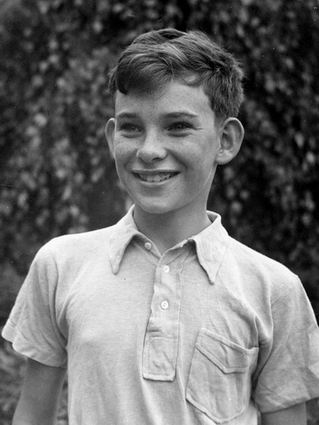
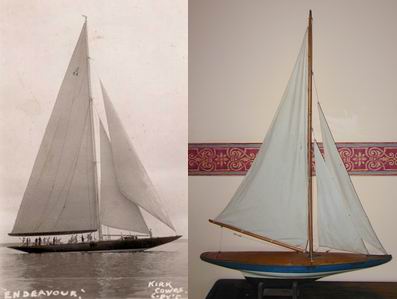
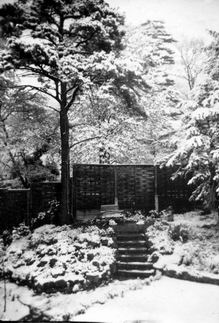
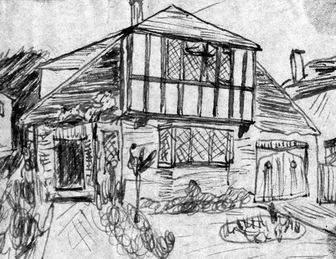
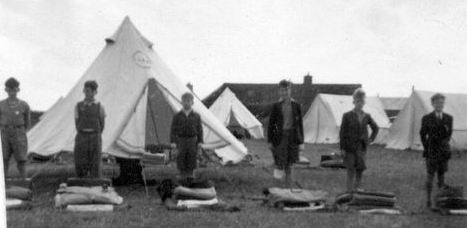
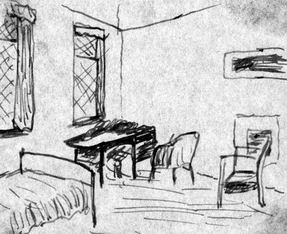 The drawing shows Colin's room with his desk and the two-bar fire which he would sit near reading. The drawing was made with a sort of "camera obscura" from a wooden box, a nice big lens from the
collection, a mirror and a glass plate on which you put some tracing paper.
Click for more details.
The drawing shows Colin's room with his desk and the two-bar fire which he would sit near reading. The drawing was made with a sort of "camera obscura" from a wooden box, a nice big lens from the
collection, a mirror and a glass plate on which you put some tracing paper.
Click for more details.
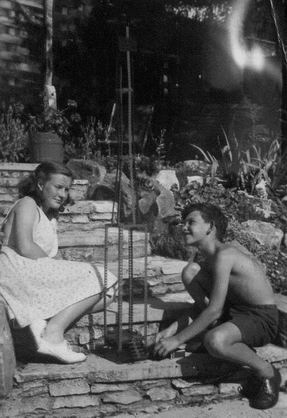
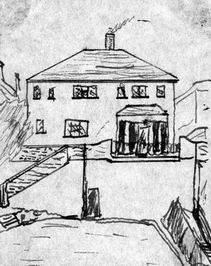

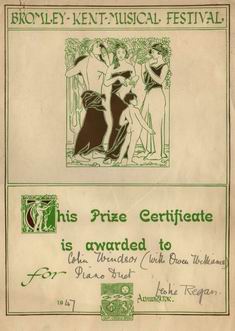
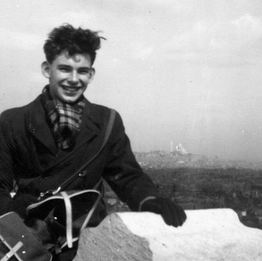
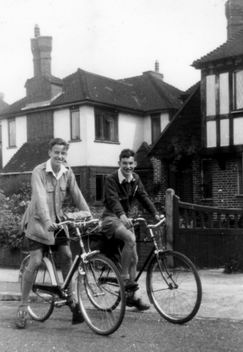
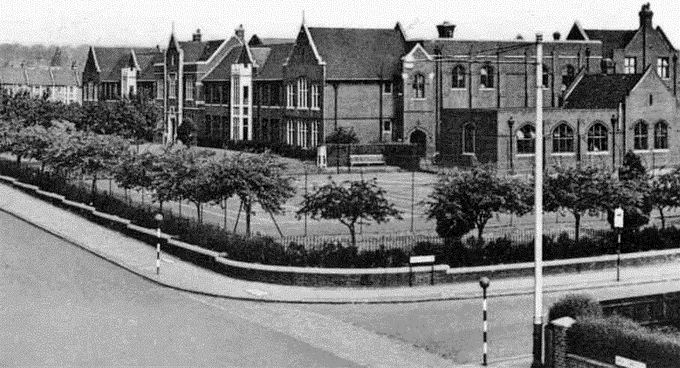

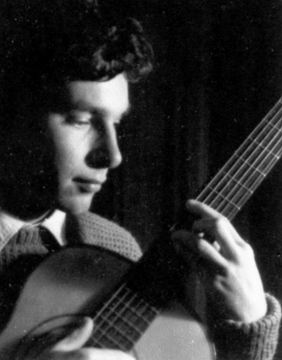
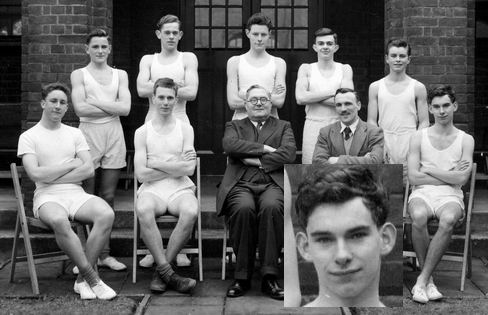
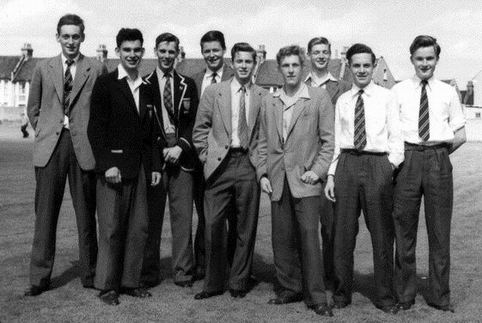
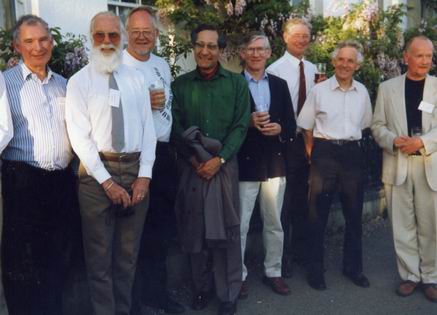
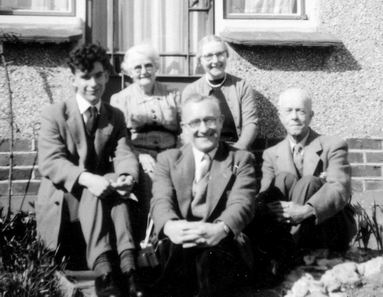

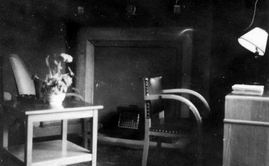
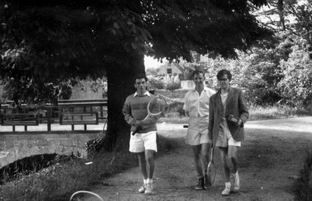


 This occupied a large room on the ground floor of an old house in South Parks Road. It too was
temperamental and had a team of electronic engineers to keep it working! One typed up a programme on paper
tape, and took it to Annette Fluendy the charming machine operator to have it sucked into the machine. She
would watch the cathode ray tube showing the inside workings to check that it was behaving reasonably.
If you were lucky, an output paper tape zoomed from the machine.
This occupied a large room on the ground floor of an old house in South Parks Road. It too was
temperamental and had a team of electronic engineers to keep it working! One typed up a programme on paper
tape, and took it to Annette Fluendy the charming machine operator to have it sucked into the machine. She
would watch the cathode ray tube showing the inside workings to check that it was behaving reasonably.
If you were lucky, an output paper tape zoomed from the machine.

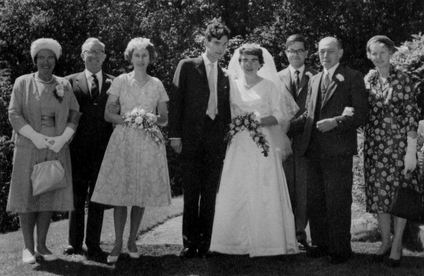

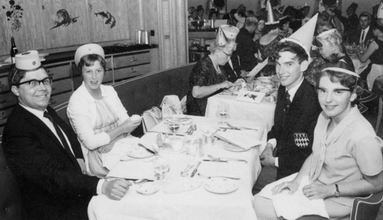


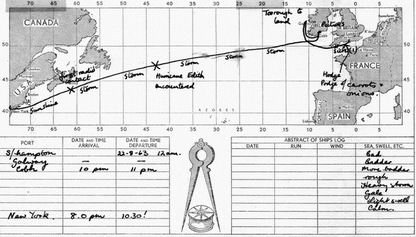
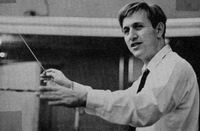
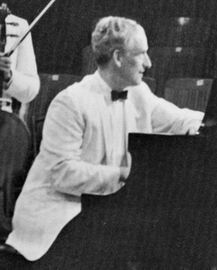
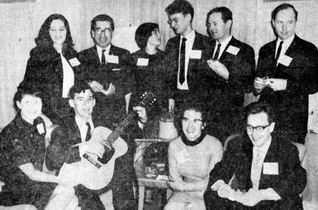
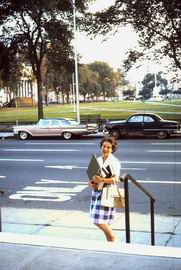
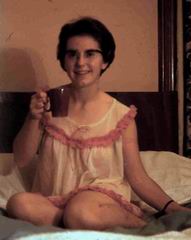
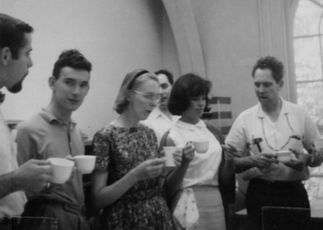
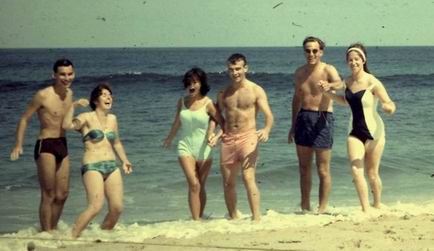

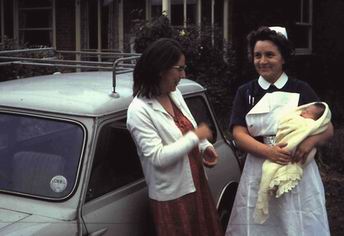
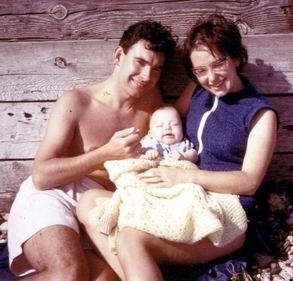
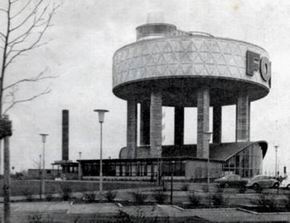
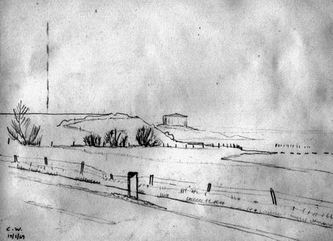
 It had a sitting tenant in a bungalow in the garden. The wood-worm in the loft was obvious.
But the hall and dining room were gorgeous. The oak staircase was dark and solid.
The landing window was enormous and had stained glass with a motto. The main rooms were gracious
and spacious. The kitchen was large and boasted two sculleries! The seven bedrooms each had their
own character.
It had a sitting tenant in a bungalow in the garden. The wood-worm in the loft was obvious.
But the hall and dining room were gorgeous. The oak staircase was dark and solid.
The landing window was enormous and had stained glass with a motto. The main rooms were gracious
and spacious. The kitchen was large and boasted two sculleries! The seven bedrooms each had their
own character.
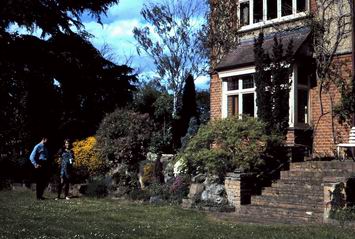

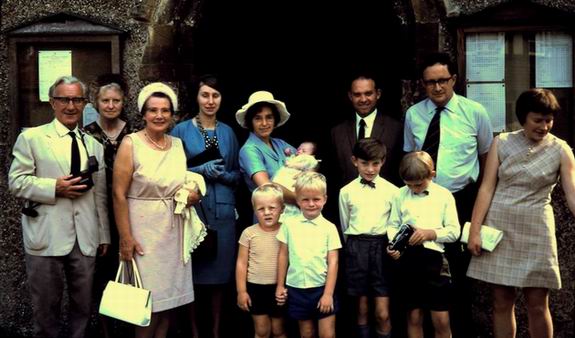
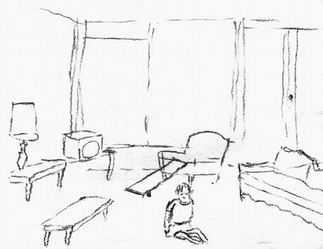
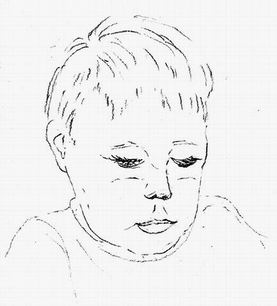
 We had lovely neighbours, Malcolm and Barbara Stocks and baby Ian, and Mike and Gheenie Harris with baby Suzanna next door. They gently eased us into American family life. Our life was very sociable. Many visitors came to our neutron group at Oak Ridge and there was usually a party every Saturday night. Our busy US diary suddenly looked blank when we returned home.
We had lovely neighbours, Malcolm and Barbara Stocks and baby Ian, and Mike and Gheenie Harris with baby Suzanna next door. They gently eased us into American family life. Our life was very sociable. Many visitors came to our neutron group at Oak Ridge and there was usually a party every Saturday night. Our busy US diary suddenly looked blank when we returned home.
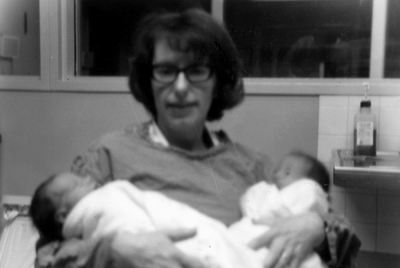
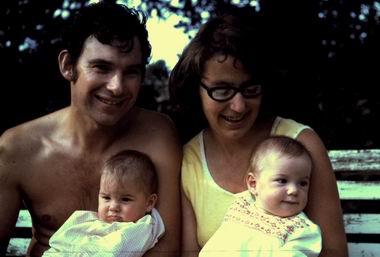
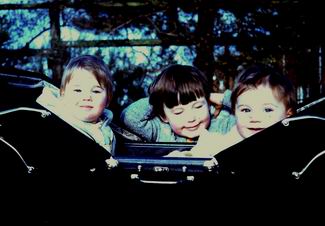
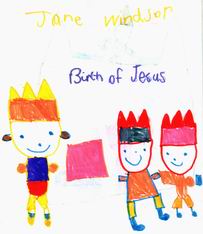
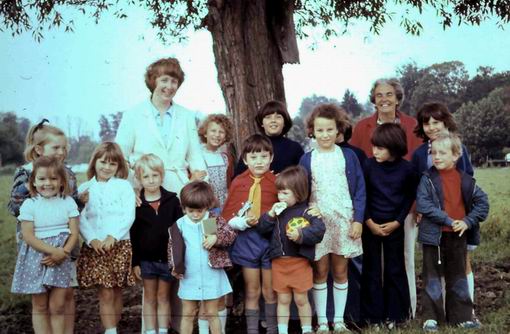
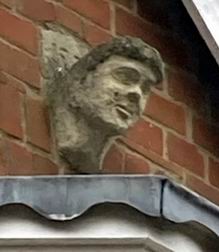
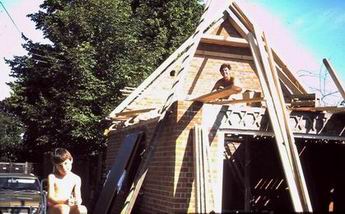
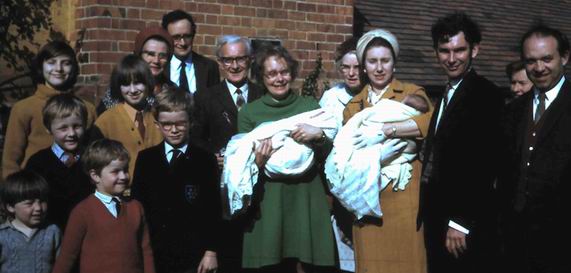 The twins Christening took place at Goring Churce in 1974 with Godmothers Elizabeth Gill for Elizabeth and Norma Blamires for Jane with all the family in attendance.
The twins Christening took place at Goring Churce in 1974 with Godmothers Elizabeth Gill for Elizabeth and Norma Blamires for Jane with all the family in attendance.
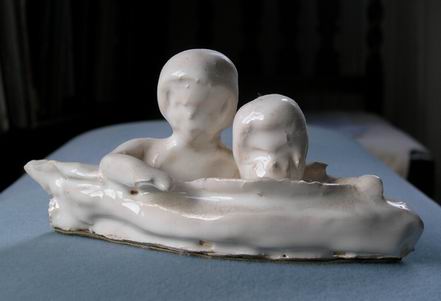
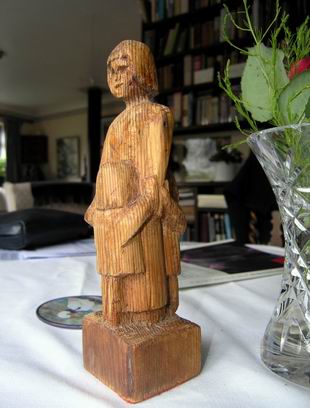 .
Wood sculpture had love been his love and on the right is Margaret with the twins in a then common position with one in front and one behind.
.
Wood sculpture had love been his love and on the right is Margaret with the twins in a then common position with one in front and one behind.
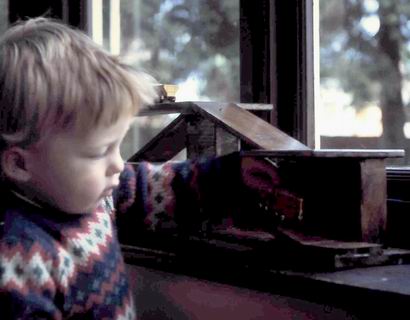
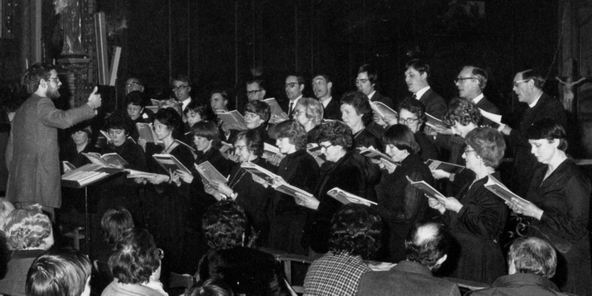
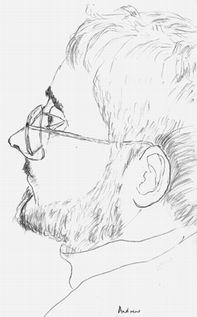
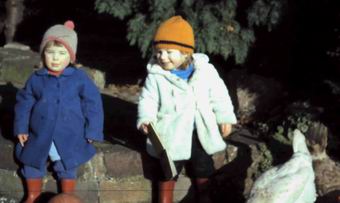
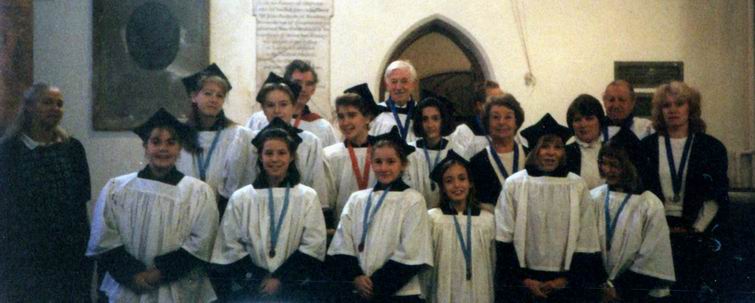
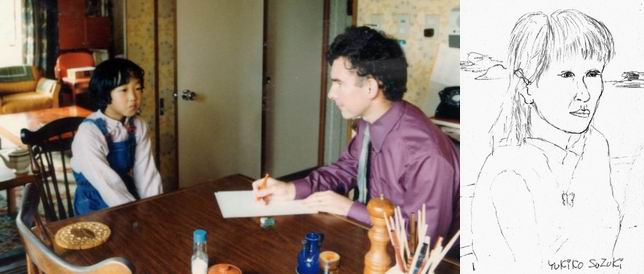

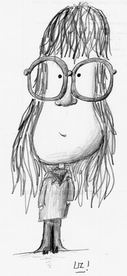
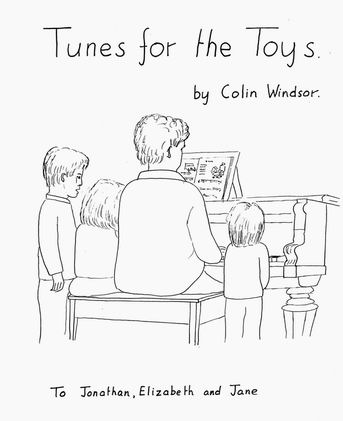 .
.
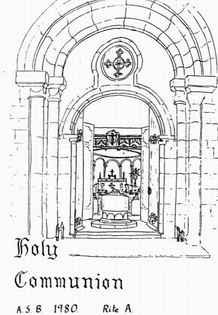 The service was sang for many years about once a month. When Mo and I joined the Streatley choir in
2004 the Anglican Common Worship had arrived and the words had to e changed again. A revised communion service was written and sung every month at St Mary's Streatley until we left in 2011.
The service was sang for many years about once a month. When Mo and I joined the Streatley choir in
2004 the Anglican Common Worship had arrived and the words had to e changed again. A revised communion service was written and sung every month at St Mary's Streatley until we left in 2011.
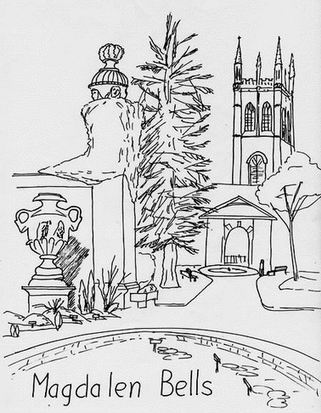
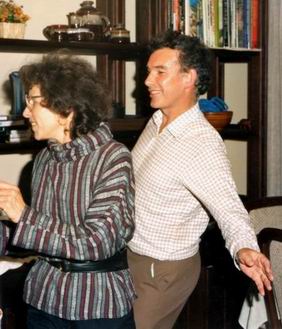

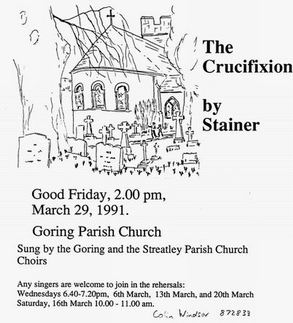
 A satisfying moment came when all the children received their degrees: Jo first at Cambridge on xx. Trinity did it with aplomb with bubbly, a splendid lunch in the quadrangle and a good speech by Master Sir Michael Atiyar PRS. Jane at Leicester on 18/7/95 was a very happy time with picnic in the sunshine. Elizabeth's on 12/6/97 at Edinburgh was a good long trip, staying at her flat, and enjoying a Ceilidh in the evening.
A satisfying moment came when all the children received their degrees: Jo first at Cambridge on xx. Trinity did it with aplomb with bubbly, a splendid lunch in the quadrangle and a good speech by Master Sir Michael Atiyar PRS. Jane at Leicester on 18/7/95 was a very happy time with picnic in the sunshine. Elizabeth's on 12/6/97 at Edinburgh was a good long trip, staying at her flat, and enjoying a Ceilidh in the evening.
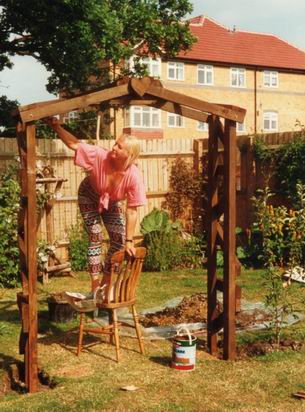
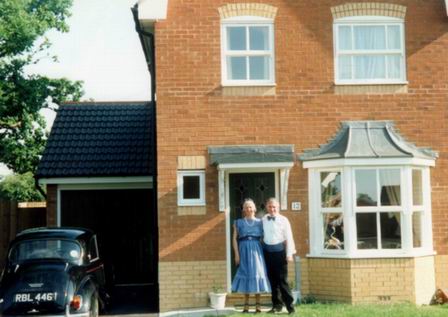
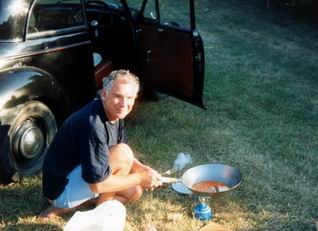
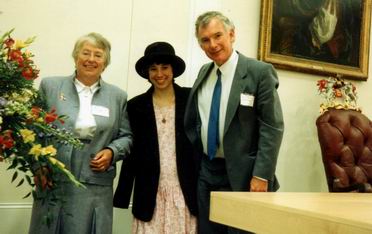
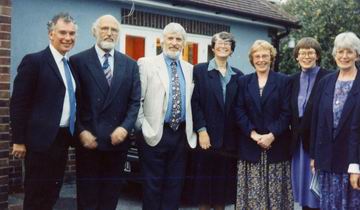
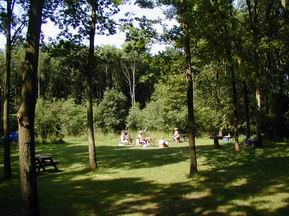
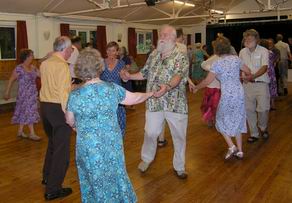





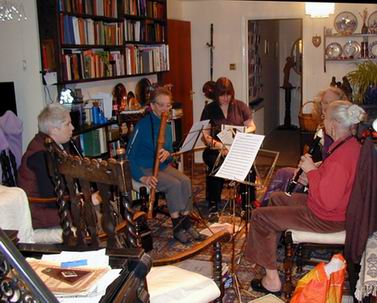
"We'd up and to the market with the gentle breeze
To buy our lunch of bread and good French cheese"
Then one day in 2002 we were on a visit to Goring's twin town of Belleme. Our host Yannick had taken us to the supermarche to pick up our coach. We wondered up the pretty rose-bordered road to St Martin and there was a lovely little house for sale. The kind lady from the twinning next door showed us round, and the equally kind notaire also from the twinning told us how to buy it. In the end it was another year before we came to complete the deal. The original house was sold, but we drove up to La Bruyere and there was a rather bigger house for sale. Soon we were being shown round by the notaire and by the young boy who lived there. Lots of work had been done by the couple who owned it but the jobs had not been finished. We made an offer and it was accepted.
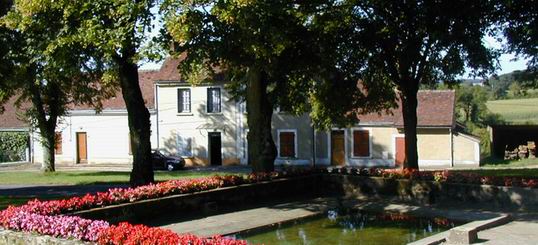
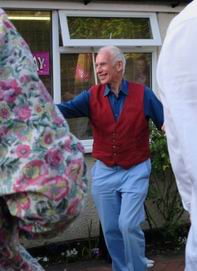



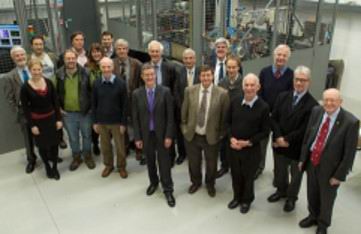
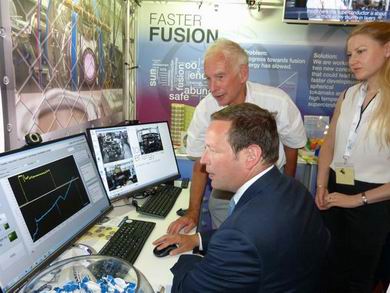
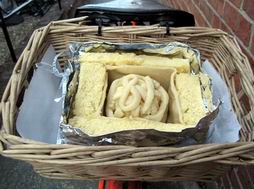
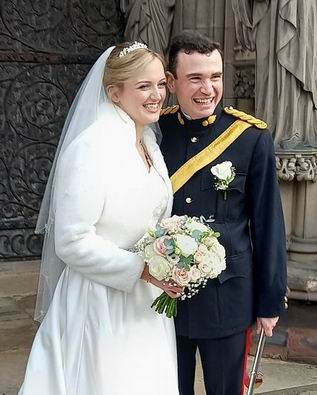
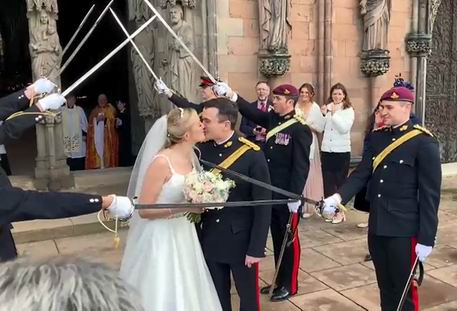 As a grand-parent it was a pleasure to have so little responsibility on the day. My only job was to make an easal stand for the table place names. The evening was wonderful with dancing till midnight which Colin much enjoyed.
As a grand-parent it was a pleasure to have so little responsibility on the day. My only job was to make an easal stand for the table place names. The evening was wonderful with dancing till midnight which Colin much enjoyed.
Copyright 2005 Colin Windsor: Last updated 30/4/2023